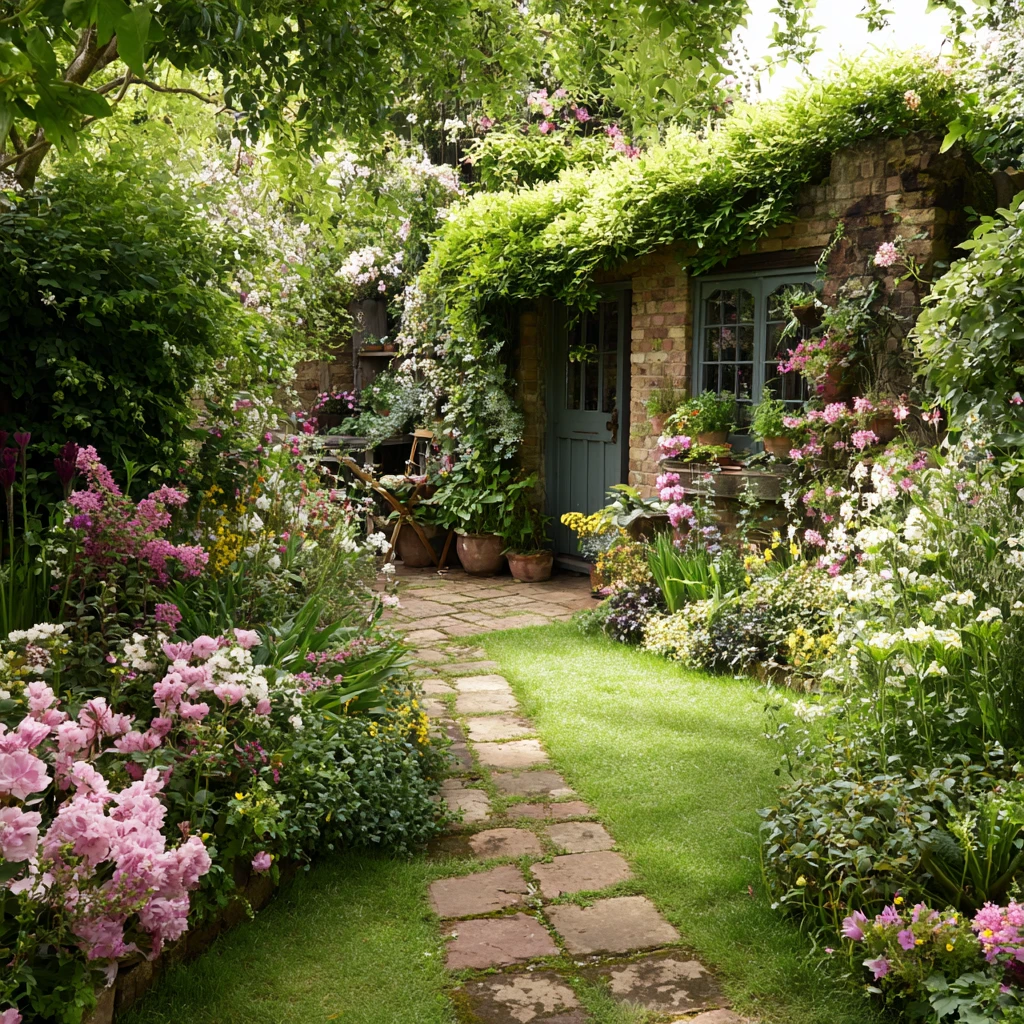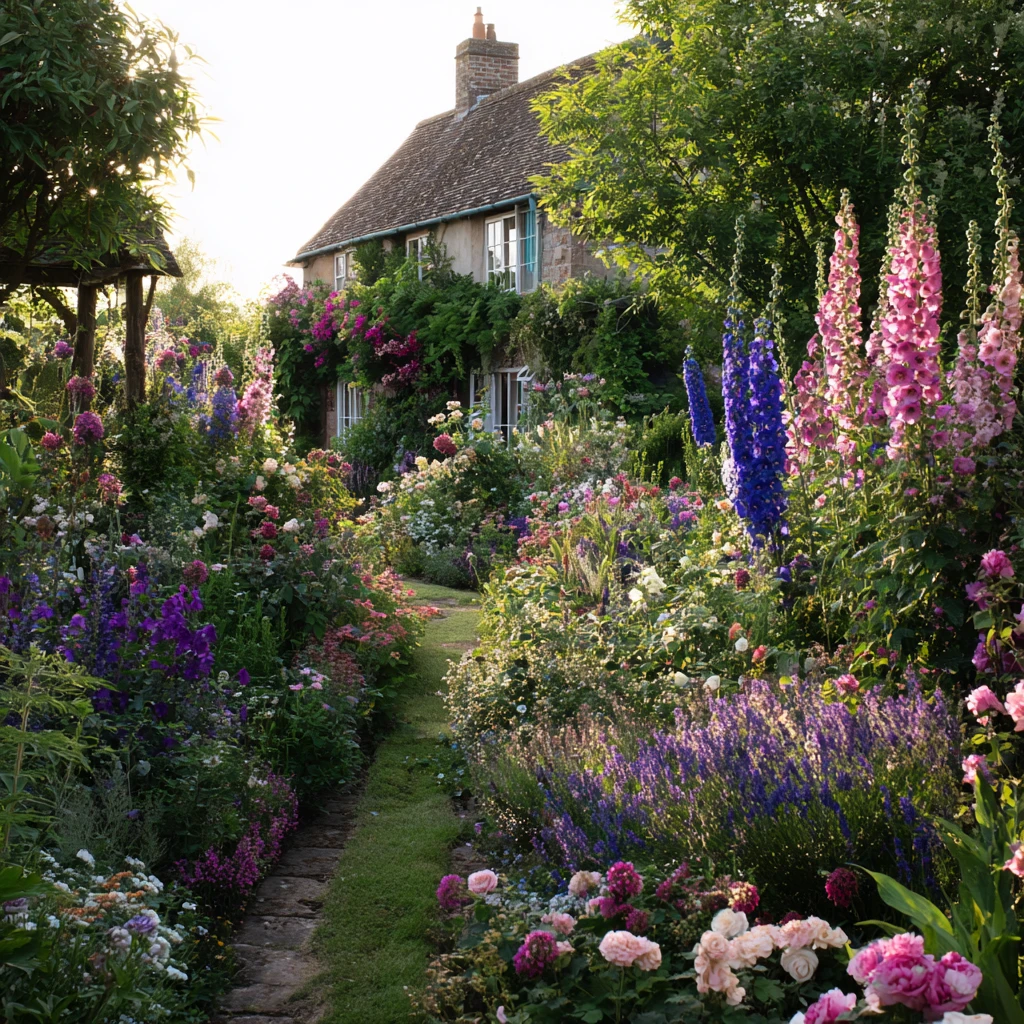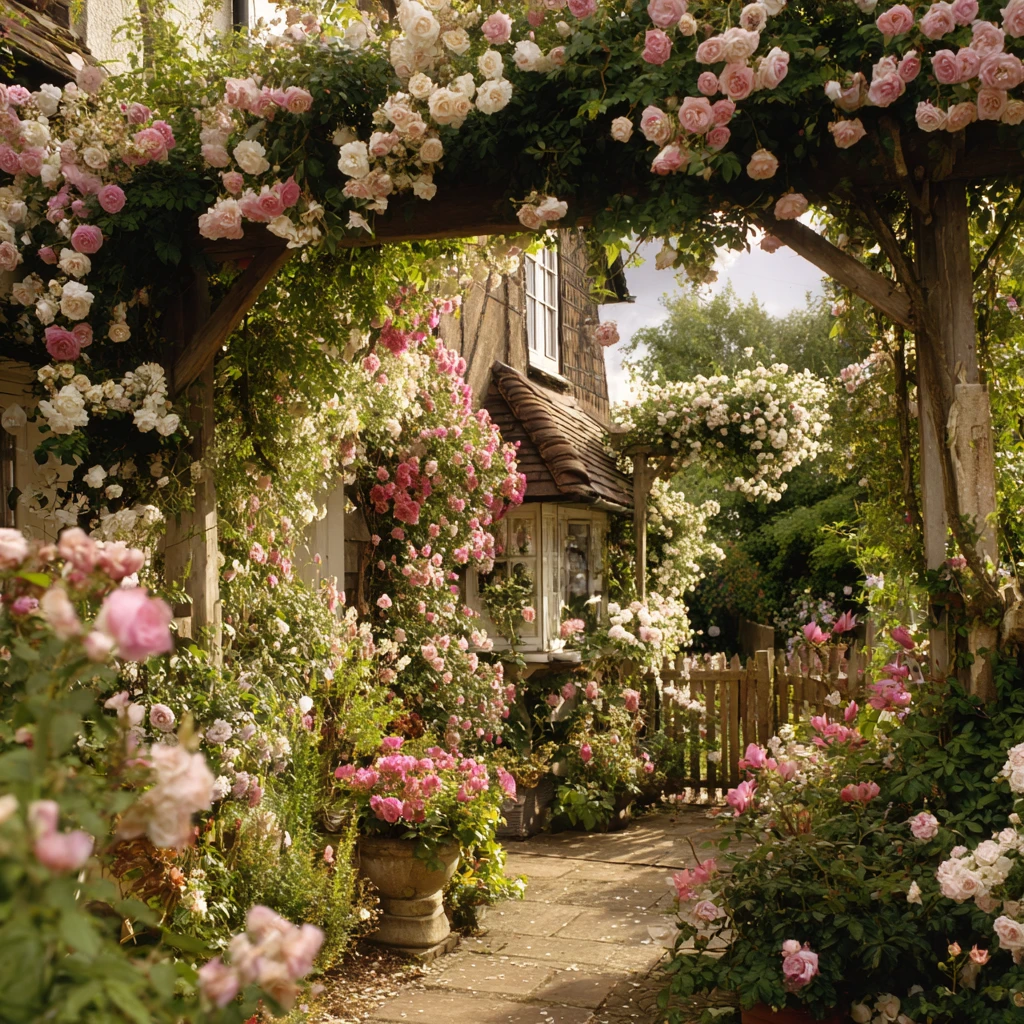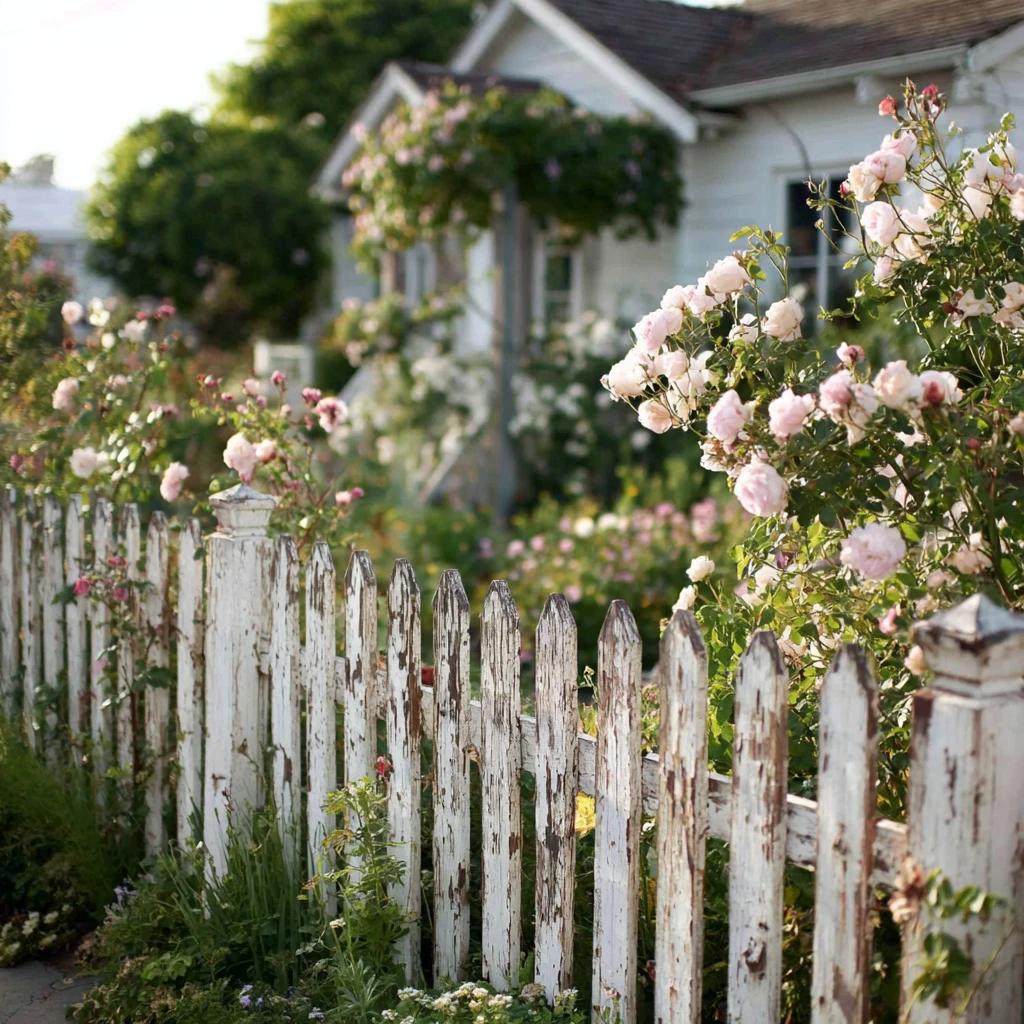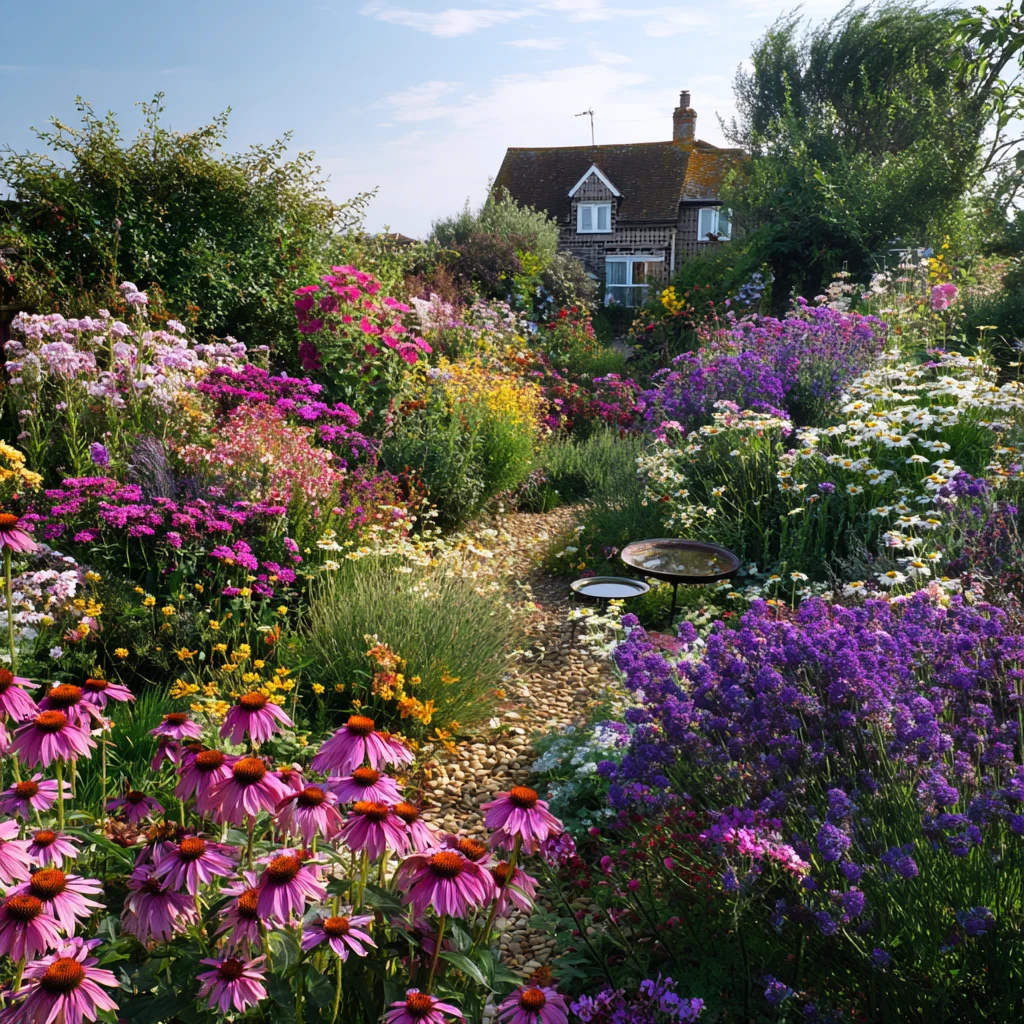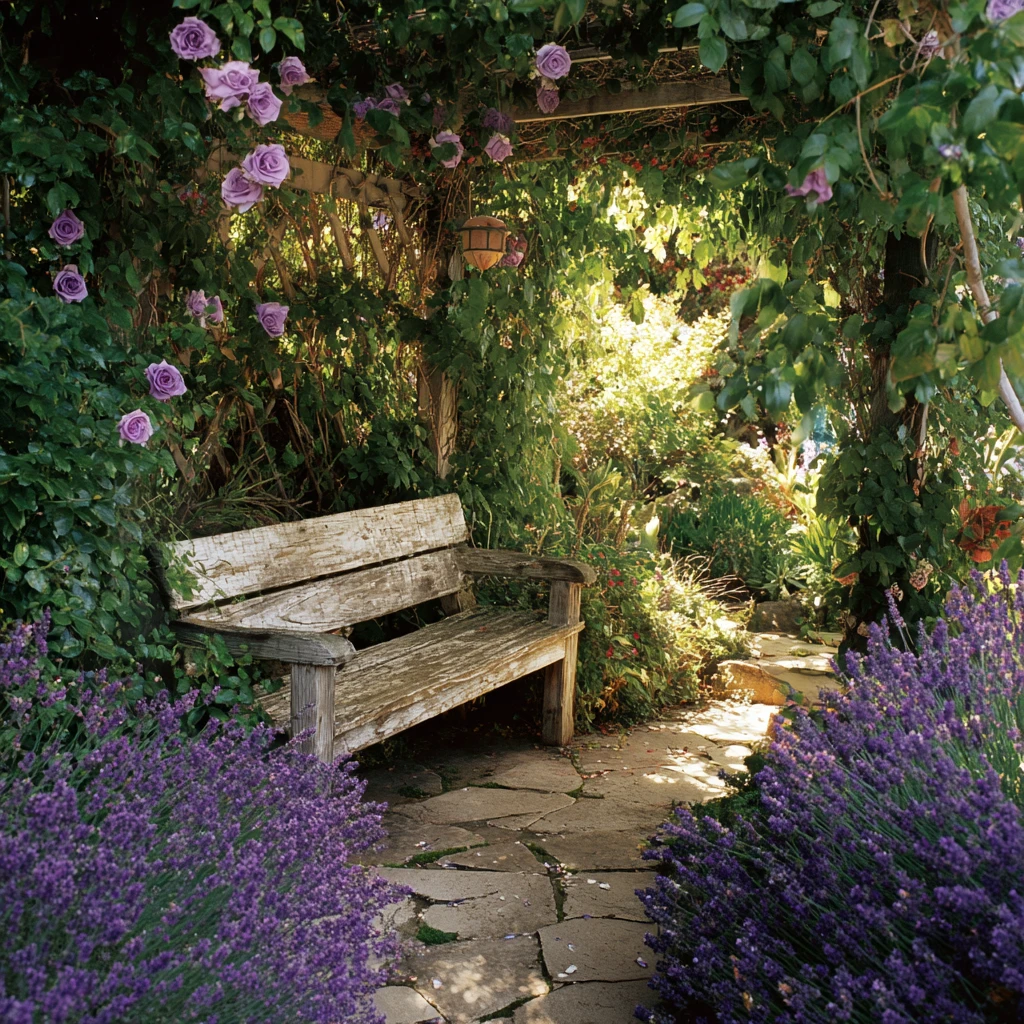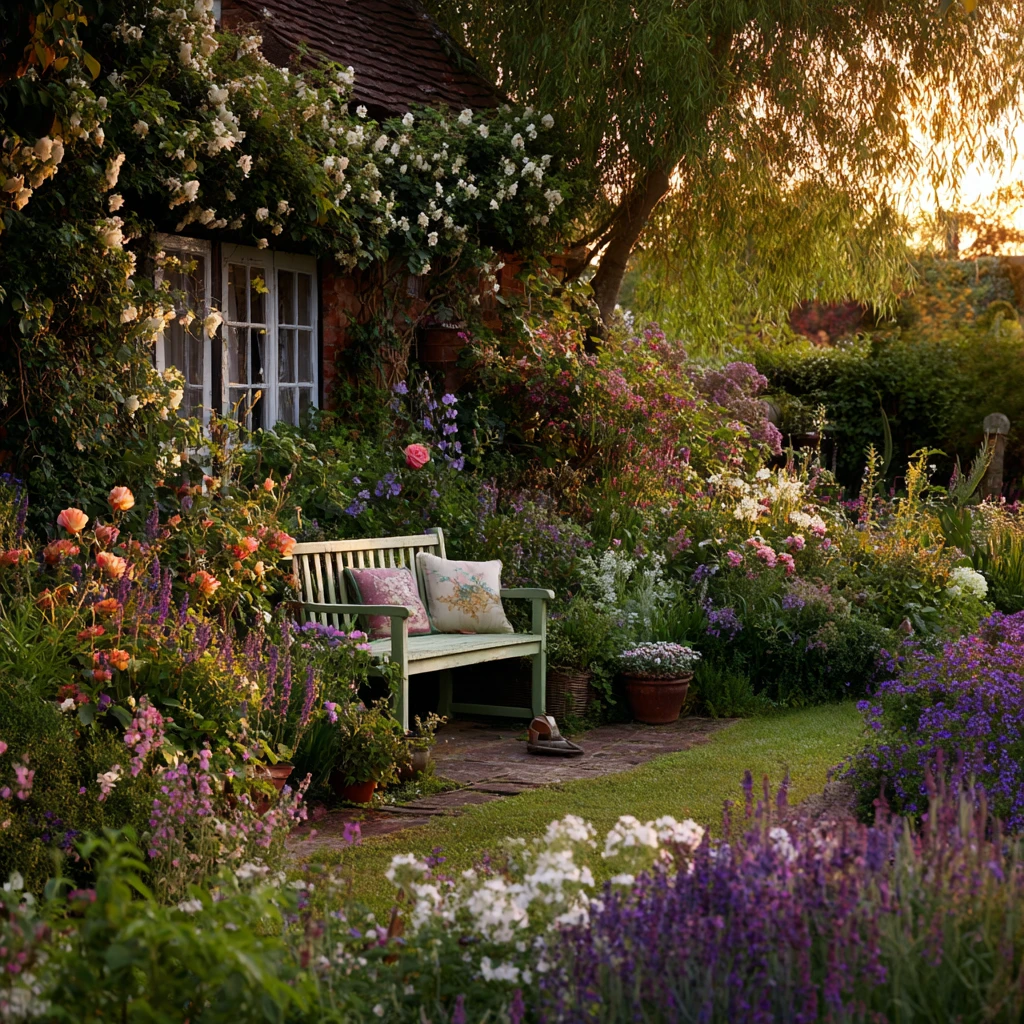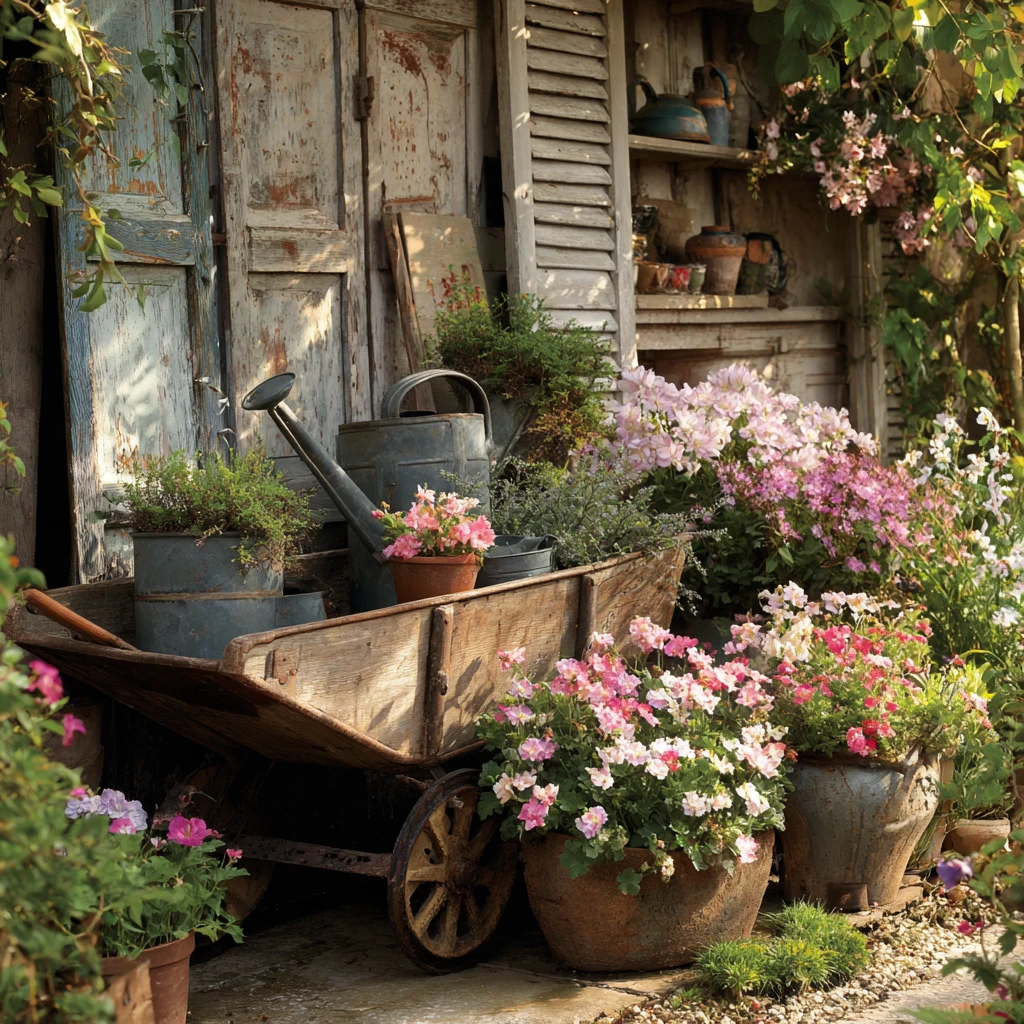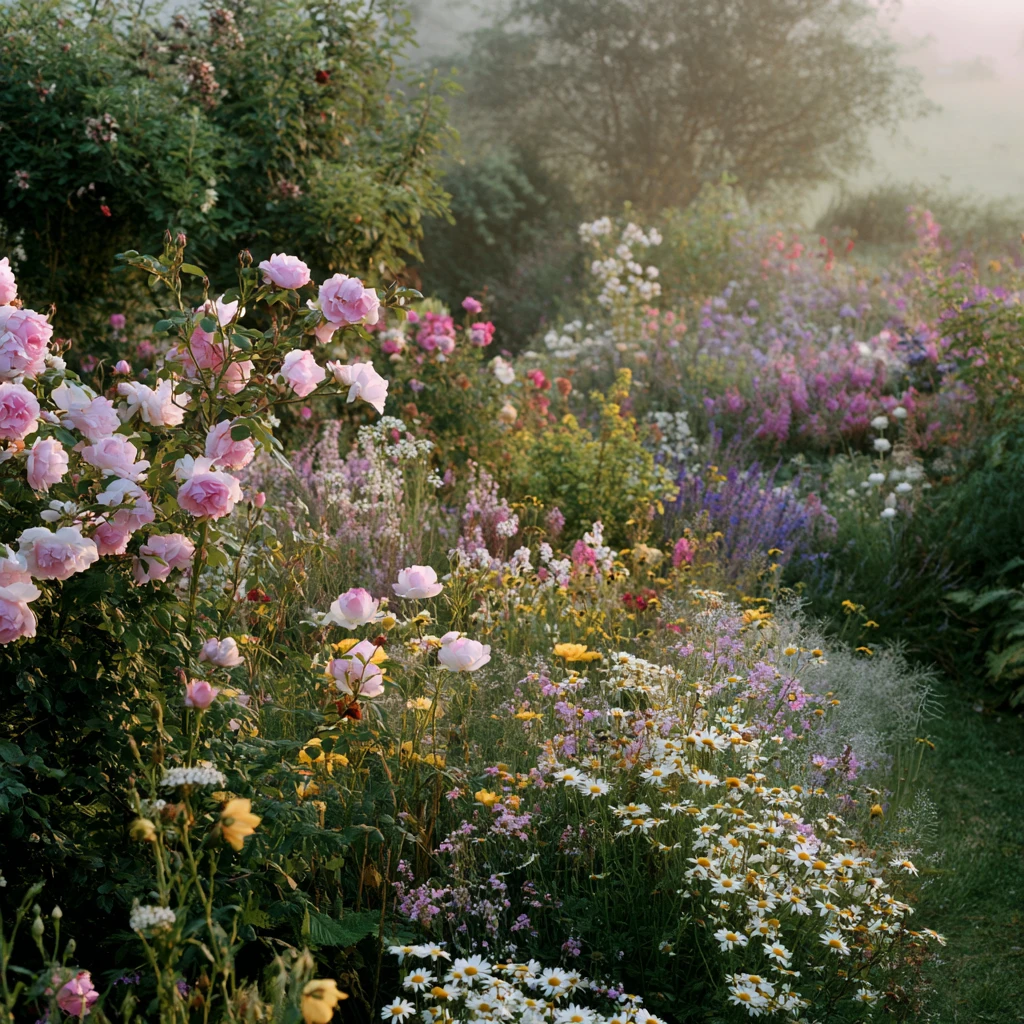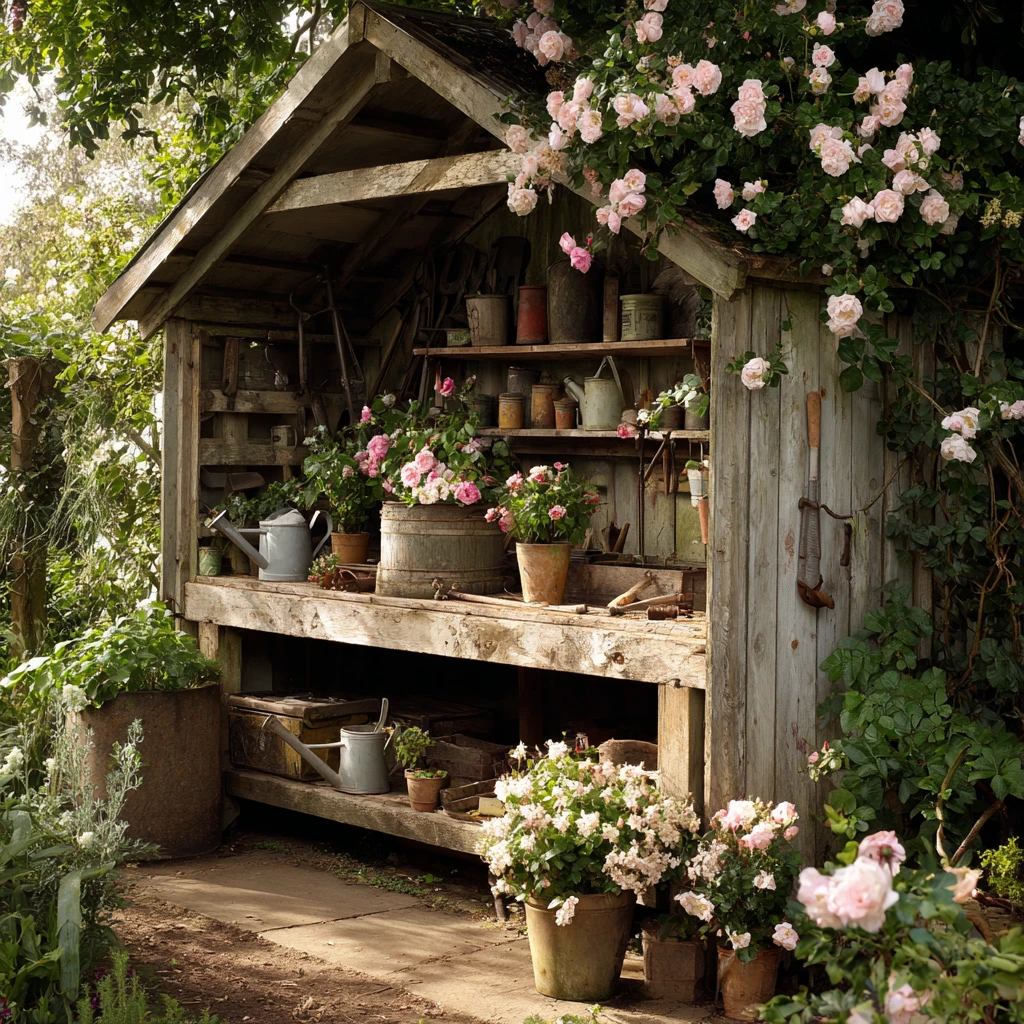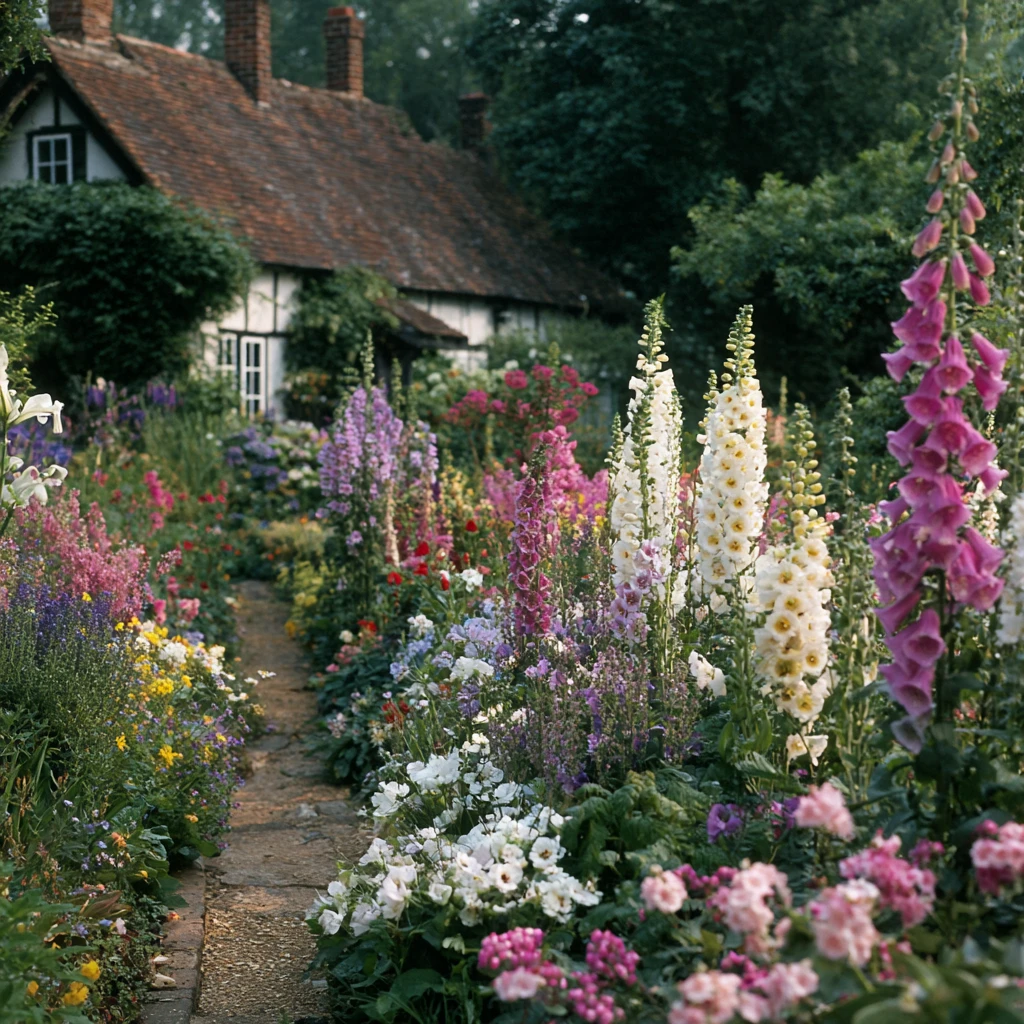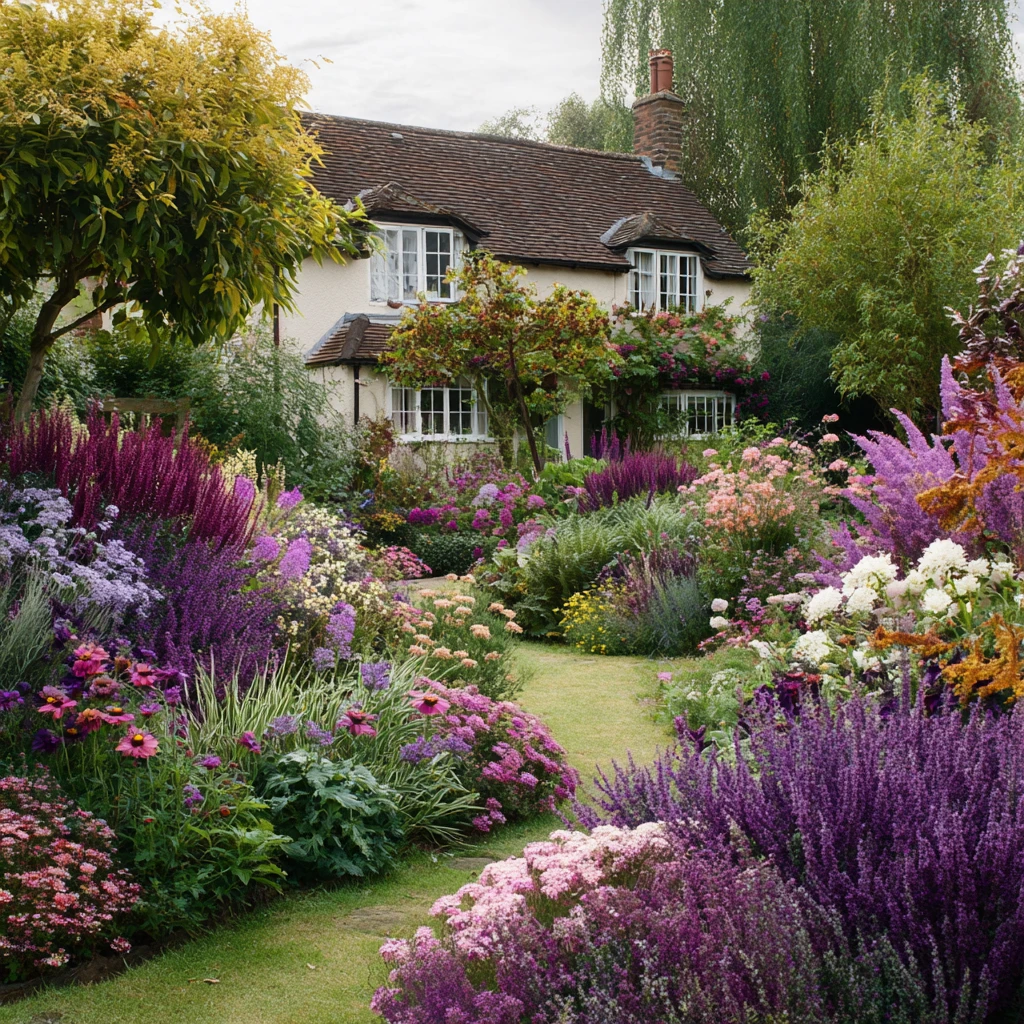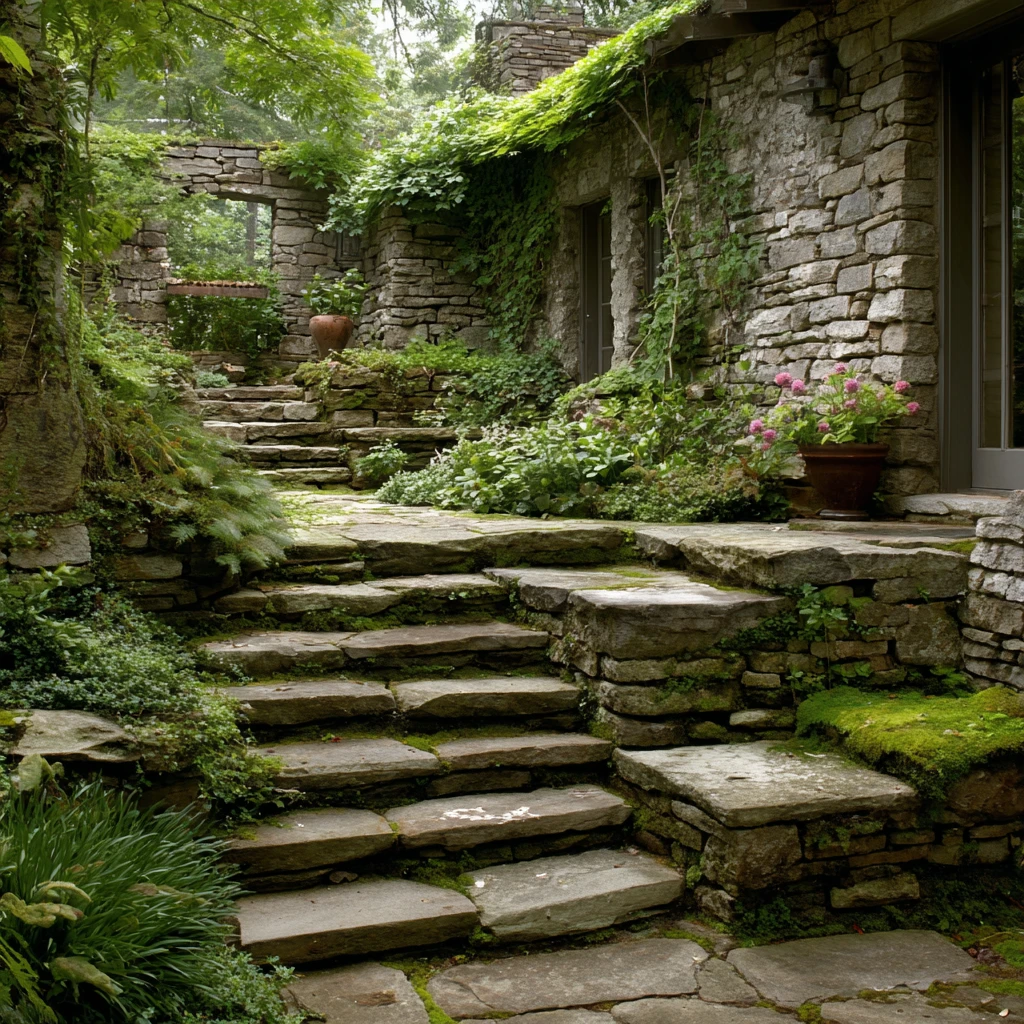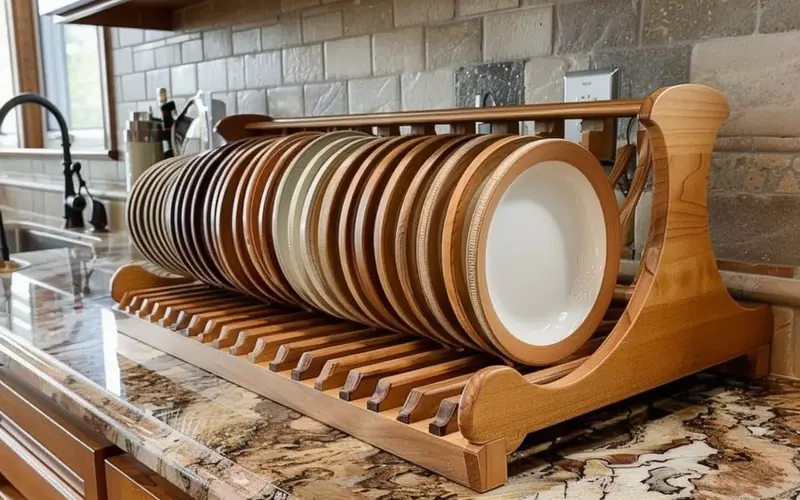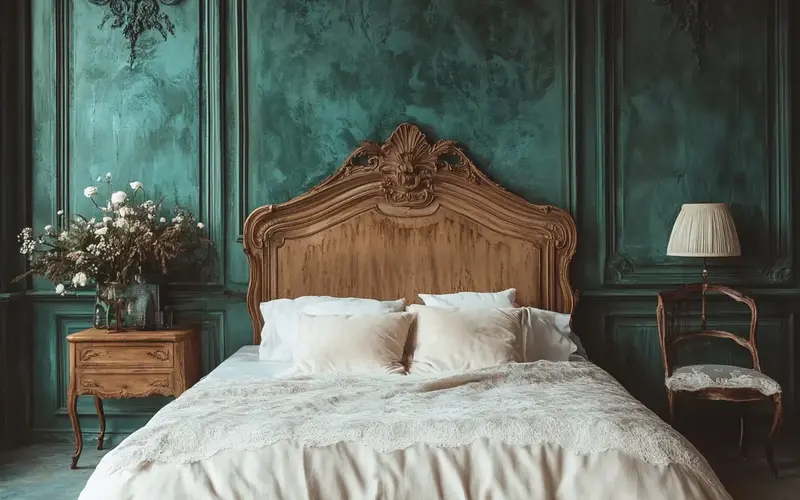Picture this: a garden where flowers spill over pathways, bees hum contentedly, and every corner feels like a page from a storybook. That’s the magic of a cottage garden. Unlike those perfectly manicured lawns that make you nervous to walk on them, cottage gardens embrace a beautiful chaos that feels both intentional and wild. I’ve spent years experimenting with different garden styles, and honestly?
Nothing beats the charm of a cottage garden when you want your outdoor space to feel like a warm hug. Whether you’re working with a sprawling backyard or a cozy corner, these ideas will help you create that dreamy, romantic vibe without breaking the bank or spending every weekend maintaining it. Ready to get your hands dirty?
1. Layer Your Plantings Like a Pro
Start with Tall Beauties in the Back: Think of your garden bed like a stage – you need those tall performers at the back so everyone gets their moment to shine. Plant delphiniums, hollyhocks, and foxgloves along the rear border. These show-stoppers can reach heights of 4-6 feet and create that classic cottage garden backdrop that makes people stop and stare. The vertical drama they add is unbeatable, and they naturally guide the eye upward, making your space feel bigger than it actually is.
Fill the Middle with Medium Heights: This is where the real magic happens. Your mid-layer plants should be approximately 2-3 feet tall and include classics such as roses, lavender, and peonies. These workhorses fill out your garden beautifully and bridge the gap between your tall back row and low front edging. I love mixing colors here – don’t be afraid to experiment with unexpected color combinations. Purple salvia next to pink roses? Yes, please.
Product Spotlight: Enhance your plants’ growth with Miracle-Gro Water-Soluble All-Purpose Plant Food to keep all these layers thriving throughout the season. Pair it with Fiskars Steel Bypass Pruning Shears for keeping your plants shaped and healthy. These tools make maintaining that layered look so much easier, and your plants will thank you with abundant blooms.
Read More: 21 Inspiring Vegetable Garden Design Ideas
2. Create Meandering Pathways with Personality
Choose Natural Materials: Say goodbye to perfectly straight concrete paths. A cottage garden needs pathways that curve and surprise you. Use flagstone, gravel, or reclaimed brick to create routes that wind through your garden beds. The irregular spacing and organic shapes invite exploration, making even small gardens feel more expansive and inviting. Additionally, the gaps between stones allow creeping thyme and other ground covers to sneak through, adding even more charm.
Make Them Narrow and Intimate: Don’t overthink the width; keep it narrow and intimate. Cottage garden paths should be just wide enough for one person, about 2-3 feet across. This creates that intimate, secret-garden feeling where flowers brush against your legs as you walk through. It forces you to slow down and actually notice the details, rather than just rushing through.
Product Spotlight: The Garden Weasel Step and Tilt Cultivator makes preparing your pathway areas a breeze, and the Rain Bird Soaker Hose works perfectly along pathways to keep border plants hydrated without getting your walking surfaces muddy. These products save time and keep your paths both functional and beautiful.
Read More: 21 Small Zen Garden Ideas for a Tranquil Home
3. Embrace the Wild Beauty of Self-Seeding Flowers
Let Nature Do the Work: Self-seeding flowers are the ultimate low-maintenance solution for cottage gardens. Plants like poppies, nigella, and forget-me-nots drop their seeds naturally and pop up wherever they please the following year. This creates that wonderfully unplanned look that’s impossible to fake. You’ll find little surprises throughout your garden each spring, and the randomness is precisely what gives cottage gardens their authentic charm.
Work with the Chaos: Instead of fighting these volunteers, embrace them. Some will end up in perfect spots you never would have thought to plant them. Others might need gentle relocation while they’re still small. This natural reseeding creates ever-changing tapestries of color year after year without you lifting a finger – well, except maybe to do a little editing here and there.
Product Spotlight: Keep your self-seeders thriving with Espoma Organic All Purpose Garden Tone Fertilizer, which feeds plants naturally without harsh chemicals. The Long Handle Weeder and Cultivator helps you manage volunteers without disturbing the good stuff. Both tools respect the organic, natural approach that cottage gardens deserve.
Read More: How to Design a Container Garden for Your Flowers
4. Add Climbing Roses for Vertical Drama
Choose the Right Varieties: Not all roses are created equal for cottage gardens. You want climbers and ramblers that bloom profusely and don’t require constant attention. Varieties like ‘New Dawn,’ ‘Climbing Iceberg,’ and ‘Zephirine Drouhin’ deliver gorgeous blooms with relatively low maintenance. They’ll scramble over arches, fences, and walls, creating those swoon-worthy scenes you see in gardening magazines.
Give Them Support Systems: Roses need something to climb on – they won’t magically attach themselves to walls like ivy. Install sturdy trellises, arbors, or wire frameworks before planting to support your vines. Train the canes horizontally rather than letting them grow straight up; this encourages more blooms along the entire length. A little guidance early on means years of spectacular displays later.
Product Spotlight: Support your climbers with Gardener’s Blue Ribbon Ultomato Tomato Plant Cage, which works surprisingly well for roses, too. Feed them with Jobe’s Organics Rose & Flower Fertilizer Spikes. These spikes deliver nutrients exactly where roots need them most, and the cages provide robust support as your roses grow.
Read More: Amazing Herb Garden Ideas for Your Outdoor Oasis
5. Mix Edibles Right into Your Flower Beds
Blur the Lines: Who says vegetables need their own separate plot? Cottage gardens traditionally combined beauty with function, and you should too. Tuck leafy greens like kale and Swiss chard between flowers – their textured foliage adds visual interest while giving you fresh salad ingredients. Herbs like purple basil and golden oregano look stunning as edging plants.
Choose Pretty Edibles: Some vegetables are genuinely ornamental. Scarlet runner beans climb beautifully and produce bright red flowers before the beans appear. Rainbow chard stems add pops of color that rival any flower. Cherry tomatoes on decorative stakes become focal points. You’re creating a garden that feeds both your eyes and your stomach.
Product Spotlight: The Gardener’s Supply Company Self-Watering Grow Bag is ideal for edibles that need to be moved around seasonally, and Dr. Earth Organic Tomato, Vegetable, and Herb Fertilizer helps keep everything producing abundantly. These products help your edible experiments thrive alongside your flowers.
Read More: 21 Corner Garden Ideas to Transform Your Backyard
6. Install a Rustic Wooden Fence
Pick Weathered Materials: Brand-new, perfect fencing looks out of place in a cottage garden. You want something with character – weathered wood, split rails, or picket fencing with peeling paint. The imperfections tell a story and provide the perfect backdrop for climbing plants and rambling roses. If you’re starting with new wood, don’t worry; it’ll age beautifully over a couple of seasons.
Keep It Low and Inviting: Cottage garden fences should be low and inviting. Aim for 3-4 feet high – just enough to define space and support plants, but low enough that neighbors can still chat over it. This creates boundaries without feeling closed off, maintaining that welcoming cottage garden vibe.
Product Spotlight: Protect and enhance your fence with KILZ Exterior Wood Stain in a weathered gray or barn red shade, and use Stanley Black Chrome Hammer for any repairs or installations. These basics help maintain that rustic charm while keeping your fence functional for years.
Read More: Stunning Flower Bed Ideas for the Front of the House
7. Create a Pollinator Paradise
Plant for Bees and Butterflies: Every cottage garden needs buzzing life. Choose nectar-rich flowers like bee balm, coneflowers, and catmint that feed pollinators throughout the growing season. Plant in clusters rather than scattering single plants around – pollinators are more efficient when flowers are grouped. You’ll notice the difference immediately when your garden becomes the neighborhood hot spot for beneficial insects.
Add Water Sources: Pollinators also need water, but they can’t drink from deep sources. Place shallow dishes with pebbles in them throughout your garden. The pebbles provide bees with a safe landing pad while they forage. Change the water every few days to prevent mosquito breeding, and observe the impact this simple addition has on activity.
Product Spotlight: Attract more pollinators with the Perky-Pet Copper Panorama Bird Feeder (yes, hummingbirds are pollinators!) and create habitat with Wildlife World Solitary Bee Hive House. These additions turn your garden into a complete ecosystem that benefits everyone.
Read More: 17 Garden Ideas for Small Spaces and Maximum Yield
8. Add a Vintage Garden Bench
Make It a Focal Point: Every cottage garden needs a designated spot to sit and take it all in. A weathered wooden bench or vintage iron seat creates an instant focal point while serving a practical purpose. Position it at the end of a pathway, tucked into an alcove, or facing your best view. This isn’t just decoration – it’s an invitation to enjoy what you’ve created truly.
Let Nature Embrace It: Don’t keep the area around your bench pristine. Let fragrant plants, such as lavender and climbing roses, surround it. Position it where afternoon shade falls naturally. The bench should feel like it’s always been there, part of the garden rather than something plopped down as an afterthought.
Product Spotlight: Restore vintage finds with Rust-Oleum Hammered Metal Spray Paint for that authentic aged look, or grab Minwax Wood Finish Penetrating Stain for wooden benches. Both products help you create or restore that perfect cottage garden seating spot without spending a fortune on genuine antiques.
Read More: How To Create a Beautiful Rose Garden To Inspire You
9. Plant Fragrant Flowers Near Seating Areas
Layer Your Scents: Fragrance makes cottage gardens truly unforgettable. Plant old roses, sweet peas, and night-blooming stocks where you’ll sit and relax. Different flowers release scent at other times – roses in warm sunshine, nicotiana at dusk. This creates a changing perfume throughout the day that you can’t get from any candle.
Consider Height and Proximity: Place fragrant plants at eye level or nose level, where possible—such as climbing sweet peas on a trellis behind a bench. Perfect. Pots of heliotrope on side tables? Even better. You want these scents close enough to appreciate without overwhelming.
Product Spotlight: Support your climbers with Gardener’s Supply Company’s Expandable Pea and Bean Trellis, and boost blooms with Schultz All-Purpose Liquid Plant Food Plus. More blooms mean more fragrance, and these products consistently deliver results.
Read More: 21 Stunning Mediterranean Garden Ideas To Inspire You
10. Use Reclaimed Materials as Garden Features
Think Outside the Box: Old watering cans, vintage wheelbarrows, and salvaged shutters become instant garden art. That rusty bucket with drainage holes? Perfect container for trailing petunias. Broken terra cotta pots? Stack them artistically as a planter tower. The weathered, imperfect look fits cottage gardens perfectly and tells a story that new stuff simply can’t.
Don’t Force It: Here’s the thing – not every old item needs to be turned into a planter. Use restraint. One well-placed vintage piece looks charming; ten look like a junkyard. Select items that genuinely complement your garden’s style and serve either a practical purpose or create a meaningful focal point.
Product Spotlight: Seal and protect reclaimed wood with Thompson’s WaterSeal Clear Wood Protector, and clean metal finds with Bar Keepers Friend Soft Cleanser. These products help vintage materials withstand outdoor conditions while maintaining their authentic character.
Read More: How To Create a Magical DIY Fairy Garden for Your Backyard
11. Install Garden Arches and Arbors
Create Living Doorways: An arch covered in climbing plants transforms any pathway into a magical space. Position arches at garden entrances, over gates, or to frame exceptional views. They add height and structure while supporting climbers – it’s a win-win. Even in winter, when plants are dormant, the bare structure adds architectural interest.
Choose Durable Materials: Metal arches last longer than wood and need less maintenance, but both work beautifully. Whatever you choose, make sure it’s sturdy – climbing roses and clematis get heavy. Nothing ruins the cottage garden vibe faster than a collapsed arch under plant weight.
Product Spotlight: The Gardener’s Supply Company Montebello Garden Arbor offers a classic cottage garden style that lasts, and Burpee Climbing Rose Seeds (or starts, if available) provide affordable climbers to cover it. Together, they create that signature cottage garden entrance everyone photographs.
Read More: Urban Gardening Solutions: Creating a Small Patio Veggie Garden
12. Plant in Informal Drifts and Clusters
Forget Rigid Rows: Cottage gardens work because plants mingle naturally. Instead of planting in straight lines, create flowing drifts of color that weave through beds. Plant odd numbers – groups of three, five, or seven – and let them overlap slightly at the edges. This mimics the natural growth of flowers, creating visual harmony.
Repeat Key Plants: Use the same varieties in multiple spots throughout your garden. This repetition creates rhythm and unity without feeling boring. Three clumps of purple catmint scattered through a bed pull everything together better than three completely different purple plants would.
Product Spotlight: Mark your planting areas with Martha Stewart Garden Fluorescent Marking Flags before you dig, and improve soil with Hoffman Canadian Sphagnum Peat Moss. These basics help you create those flowing drifts successfully from the start.
13. Add a Water Feature for Movement and Sound
Keep It Simple: You don’t need an elaborate fountain to add water to your cottage garden. A simple birdbath, small bubbling urn, or recirculating basin creates gentle sound and movement that brings gardens to life. The sound of water is incredibly soothing, and birds will thank you by visiting regularly.
Position It Strategically: Place water features where you’ll actually hear them – near seating areas or outside windows you keep open. Ensure a power source is nearby if you’re using a recirculating pump, or opt for solar options for added flexibility. The goal is a peaceful ambiance, not construction headaches.
Product Spotlight: The Sunnydaze Flowering Lily Solar Water Fountain offers a gentle water sound without the need for electrical work, while the Alpine Corporation Tiered Pedestal Water Fountain creates a more traditional cottage garden centerpiece. Both options bring that magical water element without major installation hassles.
14. Create a Cutting Garden Section
Grow Flowers for Bouquets: Designate part of your cottage garden specifically for cutting flowers. Plant rows of zinnias, cosmos, and dahlias that you won’t feel guilty harvesting. This section can be slightly more utilitarian than the rest of your garden – nobody sees it anyway when you’re cutting armfuls of blooms for the house.
Plant Succession Crops: Don’t plant everything at once. Sow new seeds every two weeks for a continuous bloom throughout the season. This staggered approach means you’ll always have something ready to cut, rather than everything blooming and fading simultaneously. It’s a simple trick that makes a huge difference.
Product Spotlight: The Fiskars Micro-Tip Pruning Snips make clean cuts that help flowers last longer in vases, and Floralife Flower Food Packets keep those cut blooms fresh for days. These small investments mean more beautiful arrangements throughout the season.
15. Use Pastel Color Schemes
Embrace Soft Tones: Cottage gardens traditionally favor soft, romantic colors—think pale pinks, lavenders, buttery yellows, and whites. These gentle hues create a dreamy, cohesive look that’s easy on the eyes and incredibly photogenic. You can undoubtedly add pops of brighter colors, but let pastels dominate for that authentic cottage feel.
Blend, Don’t Block: Instead of planting blocks of single colors, let them blur together. Plant pink roses near purple lavender, with white daisies peeking through. This intermingling creates depth and interest that single-color groupings can’t match. The colors should flow into each other like watercolors on paper.
Product Spotlight: Start seeds indoors with Burpee Self-Watering Seed Starting Tray, and choose varieties from Botanical Interests Cottage Garden Flower Mix Seeds for perfectly coordinated pastel blooms. These products eliminate the guesswork in creating a soft, romantic color palette.
16. Add a Potting Bench or Small Shed
Create a Functional Focal Point: A weathered potting bench or small shed becomes both practical storage and a charming architectural element. Choose designs with open shelving where you can display pretty watering cans, vintage tools, and blooming plants. This workspace helps keep your garden organized while adding that lived-in cottage appeal.
Style It Right: Don’t let it become cluttered chaos. Keep frequently used tools within easy reach, store soil amendments in attractive containers, and use old crates or baskets for organization. The goal is functional beauty – everything should earn its place.
Product Spotlight: The Hopkins Basics Shed Kit provides the framework for a DIY storage solution, while the Best Choice Products Outdoor Garden Potting Bench offers a ready-made workspace. Either option creates that essential cottage garden work area.
17. Include Old-Fashioned Cottage Favorites
Plant Heritage Varieties: Some flowers are designed explicitly for cottage gardens because they’ve been cultivated for centuries. Hollyhocks against walls, foxgloves in dappled shade, sweet williams in cheerful clusters – these classics create instant cottage garden credibility. They’re not trendy; they’re timeless.
Embrace Their Quirks: Many heritage flowers have shorter bloom times than modern hybrids, but their authentic charm makes up for it. They often self-seed readily (bonus!), attract pollinators in abundance, and require minimal fuss. Sometimes old-fashioned really is better.
Product Spotlight: Get started with David’s Garden Seeds Flower Hollyhock Mix and Outsidepride Foxglove Flower Seed Mix. These packets bring those essential cottage garden classics to your space affordably, with varieties that have proven themselves over generations.
18. Create Multi-Season Interest
Plan for Year-Round Beauty: Don’t let your cottage garden look amazing in June and sad the rest of the year. Include spring bulbs, summer perennials, fall asters, and evergreen shrubs for structure. Even winter should offer something – dried seed heads, berries, interesting bark textures.
Layer Bloom Times: Map out bloom times before planting to ensure optimal growth. Early spring daffodils and tulips, late spring peonies, summer roses and daylilies, fall sedums and ornamental grasses. This succession keeps your garden photogenic throughout the growing season, rather than peaking once and then fizzling out.
Product Spotlight: Extend your season with Perfect Plants Black-Eyed Susan Rudbeckia for late summer color, and add structure with Breck’s Premium Tulip Bulbs for spring. These investments ensure your cottage garden looks intentional year-round, not just during peak growing season.
19. Use Natural Stone Elements
Add Permanent Structure: Natural stone brings gravitas to cottage gardens without feeling formal. Use it for edging beds, creating small walls, or building raised planters. The irregular shapes and weathered surfaces complement cottage garden aesthetics perfectly, and stone only looks better as it ages and moss begins to grow.
Think Function First: Stone should serve a purpose beyond decoration. Edge a pathway to prevent gravel spread, create a low wall for tiered planting, or build a small stone circle for a fire pit. When stone elements are functional, they feel integral to the garden rather than added as an afterthought.
Product Spotlight: Place stones accurately with True Temper Steel Garden Rake, and fill gaps with Scotts EZ Seed Patch and Repair for instant greening. These tools help you work with stone effectively while maintaining that natural, established cottage garden look.
20. Plant for Evening Enjoyment
Include Night Bloomers: Some flowers save their show for evening – four o’clocks, moonflower, night-blooming jasmine. Plant these near patios or bedroom windows where you’ll actually be around to appreciate them. Their scents intensify at dusk, creating an entirely different garden experience after sunset.
Add White and Silver: White flowers and silver foliage practically glow in moonlight, making evening gardens feel magical. Plant white roses, silver artemisia, and white-flowering tobacco. These light-reflective plants transform your cottage garden into an enchanted space once darkness falls.
Product Spotlight: Grab Burpee Moonflower Seeds for spectacular evening blooms, and install Litom Solar Landscape Spotlights to highlight your night-blooming treasures. Together, they extend your garden enjoyment long after the sun sets.
21. Display Vintage Garden Decor Thoughtfully
Less Is More: A few carefully chosen vintage pieces create charm; too many create clutter. An old enamel pitcher used as a planter? Lovely. A rusty watering can tucked beside your potting bench? Perfect. A dozen random antiques scattered everywhere? Overwhelming. Choose pieces that genuinely resonate with you and give them space to shine.
Let Plants Take Center Stage: Vintage decor should complement your plants, not compete with them. Use decorative elements to draw the eye toward blooming areas or frame beautiful views. The flowers are the stars; everything else is the supporting cast.
Product Spotlight: Restore finishes with Krylon ColorMaster Paint + Primer for metals that need refreshing, and seal wooden pieces with Minwax Helmsman Spar Urethane. These products help vintage treasures withstand outdoor conditions while maintaining their authentic character.
Final Thoughts
There you have it – 21 ways to create the cottage garden of your dreams. The beauty of cottage gardens lies in the fact that there’s no single right way to do it. Mix and match these ideas based on your space, climate, and personal style. Start with a few favorites, see what works, and expand from there. Your garden should reflect your personality, not some rigid rulebook.
So grab those gardening gloves, get outside, and start creating your own whimsical wonderland. Trust me, once you see those first blooms spilling over pathways and bees happily buzzing around, you’ll understand why cottage gardens have enchanted people for centuries. Happy gardening!
